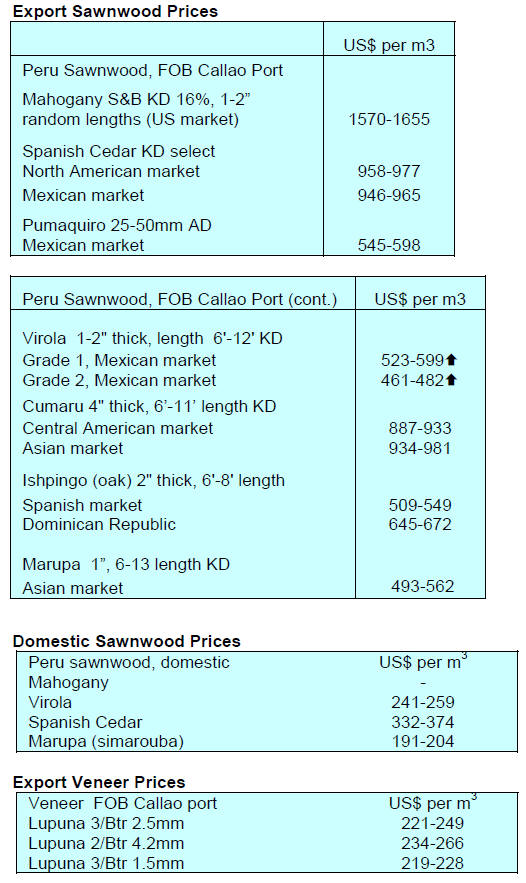2. GHANA
Export volumes slump
The volume and value of Ghana’s timber exports has been
falling in each of the past five months. According to the
Timber Industry Development Division (TIDD) of the
Forestry Commission, the country secured Euro 62.65
million from the export of 116,952 cu.m of wood products
in the first 5 months of this year representing a 27% drop
in value and a 31% drop in volumes compared to the same
period in 2016.
The average unit price of wood products in the period
January to May 2017 dropped to Euro 536/cu.m from Euro
564/cu.m in the same period in 2016, an almost 5%
decline.
Secondary wood products (sawnwood, boules, veneers and
plywood) accounted for 82% of exports followed by
primary product exports (poles and billets) 7% with the
balance being tertiary wood products (mouldings, flooring,
dowels and furniture parts).
Asian markets accounted for close to 70% of all wood
product exports with China and India being the leading
importers.
EU imports of wood products from Ghana have been
falling over the past months. Analysts suggest the fall in
exports is most likely linked to the growing problem mills
have in securing adequate log supplies.
Because this is seen as a long term problem some millers
are asking the government to allow timber imports which
would secure existing businesses, maintain employment in
the sector and possibly lead to more investment in
processing capacity.
Growth to get boost from extension of IMF credit
facility
The Government of Ghana has extended its credit facility
programme with the International Monetary Fund (IMF)
by a year. This follows the conclusion of an assessment of
the Extended Credit Facility by the IMF’s board. The
Fund has also approved a US$94 mil. disbursement to the
government as part of the overall US$918 mil. support
programme.
A lecturer at the University of Ghana, Dr. Eric Osei-
Assibey, has applauded the extension saying it will boost
investor confidence in the economy. Ghana’s Vice
President, Dr. Mahamudu Bawumia, has said economic
growth could top 6% by the end of this year.

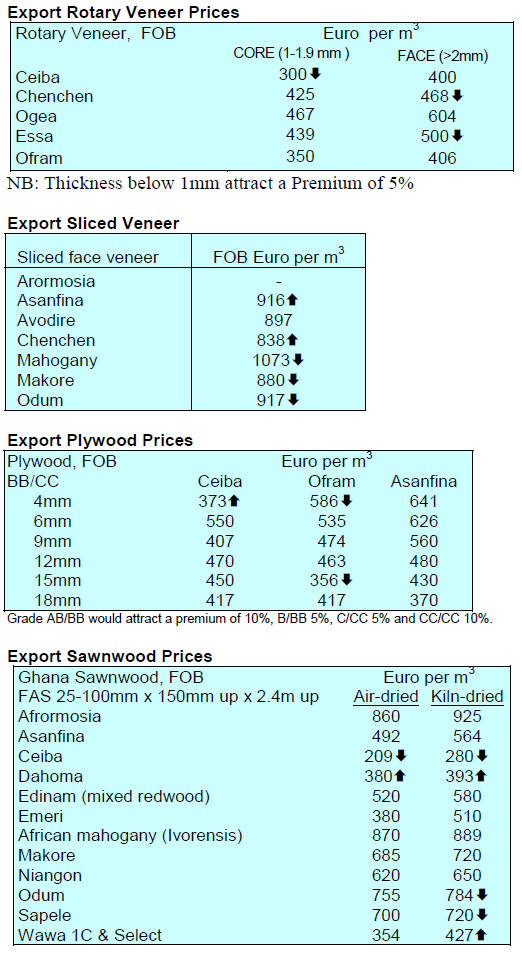
3.
SOUTH AFRICA
Out of recession but growth tepid
GDP figures for the second quarter of 2017released by
Statistics South Africa (StatsSA) showed growth of 2.5%,
a reversal of the 0.7% decline reported in the first quarter.
Analysts say that, while the South African economy has
snapped the technical recession, GDP growth is not strong
enough with projections for 2017 GDP likely to be below
1%.
The South African economy has been dragged down by a
deterioration in both consumer and business confidence,
much of which is due to the uncertain political
environment.
Negative sentiment and weak currency weighing on
construction sector
According to StatsSA, the total value of recorded building
plans passed in the country grew by 6% cent in 2016
compared to a year earlier.
However, the pace of growth slowed this year due to
the
economic slowdown, poor investor sentiment, high
unemployment and a weak currency all of which are
weighing on the construction sector spending.
Government efforts to balance supply and demand for
social housing will be the main driver of demand for new
residential units and the continued trend to urbanization is
generating demand for residential and infrastructure
development.
Take-aways from Master Builders’ Congress
Speaking at the Annual Congress of Master Builders SA
the South African Minister of Economic Development,
Ebrahim Patel, said the his department is consulting with
the National Treasury with a view to securing a multiyear
budget system which would help the construction
sector weather the cyclical trends in investment especially
for large scale projects.
In looking ahead the Minister said” the South African
economy has been impacted by the change in China’s
growth model and by African growth levels tapering
down”.
Adrian Saville, Chief strategist at Citadel Investment
Services, told the Master builders Congress that spending
on its infrastructure development projects are key in
driving the economy forward but that government
investment in infrastructure has fallen and is dragging
down the overall economy .
Data show that infrastructure investment had fallen below
target by between 1.8% and 3.8% over the past 5 years. He
pointed out that “South Africa required an infrastructure
investment rate of between 7 to 9 percent per annum to see
any real growth in the economy. The country has only
invested 5.2 percent from 2010 to 2015.”
In concluding he said prospects are not good as the South
African economy is not growing fast enough to lower
unemployment.
4.
MALAYSIA
Raw material and labour shortages
to drive down
export prospects
The Ministry of Plantation Industries and Commodities
(MPIC) has revised projections of the country’s woodbased
exports from RM53 billion a year to between RM25
and RM30 billion by 2020. In 2009, the MPIC had
projected that the wood-based exports will hit RM53
billion by 2020.
Minister Mah Siew Keong said the revision was made due
to a likely shortage of raw material as well a shortage of as
skilled and unskilled workers. First half year wood product
exports totalled RM11.5 billion, a 5.2% increase year-onyear.
In 2016, exports stood at RM22 billion.
Mah said it is crucial for the government and sector
stakeholders to overcome the shortage of labour and of
raw materials and to embrace e-commerce and
digitalisation to improve profitability.
At a recent National Timber Industry Policy (NATIP)
gathering, the Minister reported that his ministry will also
implement a national initiative, namely the development
of the 2050 National Transformation Plan for the
commodity sector including the timber industry.
Belt and Road Initiative
After the new US administration pulled out of the Trans
Pacific Partnership the attention of Malaysia has shifted to
China’s Belt and Road Initiative (BRI). This is perhaps
China’s biggest initiative to date in an effort to energise
the global economy through infrastructure projects in 65
countries.
The BRI refers to the land-based "Silk Road Economic
Belt" and the seagoing "21st Century Maritime Silk
Road". The routes cover more than 60 countries and
regions from Asia to Europe via Southeast Asia, South
Asia, Central Asia, West Asia and the Middle East,
currently accounting for some 30 per cent of global GDP
and more than 35 per cent of the world's merchandise
trade.
Malaysia is assessing the potential in the new markets
being opened up by the BRI especially commodity
products. In 2016, exports of major commodities were:
palm oil RM 67.58 billion; rubber and rubber products
RM 24.79; timber and timber products RM 21.86 billion
and cocoa RM 5.74 billion.
Boosting furniture sales to China
In a 10 September press release the Malaysian Timber
Council (MTC) said China continues to provide healthy
gains for Malaysian furniture manufactures. The two
countries have enjoyed healthy trade ties and aim to
achieve a bilateral trade worth US$160 billion by 2020.
In 2016, timber and wood products exports to China were
valued at RM846.8 million, an almost 4% increase from
the previous year. Furniture remains the main export of
Malaysian timber products to China in value terms,
amounting to RM121.7 million which marks a 91%
increase from the previous year.
To build on the strong trade ties the MTC participated in
the China International Furniture Expo organised by the
China National Furniture Association and Shanghai UBM
Sinoexpo International Exhibition Co Ltd.
This year, the exhibition was held 12-15 September at the
Shanghai New International Expo Centre (SNIEC) in
Pudong, Shanghai, China. The exhibition will run
concurrently with the Furniture Manufacturing and Supply
China 2017 event at SNIEC.
Last year, 18 companies participated in the fair under
MTC’s Malaysia Pavilion. This year, MTC lead a
delegation of 20 companies to showcase their best selling
products under the Council’s Malaysia Pavilion.
For more see:
http://mtc.com.my/images/media/508/201707_Furniture_China_
2017_-_Pre_release_ENG.pdf
Agarwood entrepreneurs promote wide range of
products
The Malaysian Timber Industry Board (MTIB) organised
the inaugural Malaysia Agarwood Fair to further develop
the Karas (Kekaras) and Agarwood industry in Malaysia.
The exhibition was held in Kuala Lumpur. This three-day
exhibition gathered Malaysian Agarwood entrepreneurs
and promoted their products to the public. It was also a
platform for local entrepreneurs to exchange ideas and
experience of agarwood.
Kekaras is a gaharu-producing tree from the Aquilaria
species. There are 22 Aquilaria species worldwide, out of
which five are found in Malaysia namely; Aquilaria
malacenssis, beccariana, hirta, rostrata and microcarpa.
Locally known as gaharu, Agarwood is now considered an
important non-timber forest product. It has been used for
hundreds of years for medicine and as basic material to
produce perfumes. Today, Agarwood is traded in more
than 18 countries and demand has risen significantly over
the past 30 years.
August plywood prices
Plywood traders based in Sarawak reported the following
export prices:
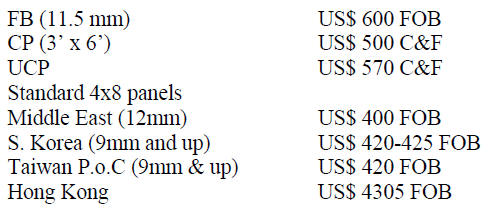
5. INDONESIA
SFM information system to be launched
Indonesia’s Ministry of Environment and Forestry has
launched a Sustainable Forest Management Information
System (SIPHPL). The system is intended to improve
transparency and accountability in the timber supply
chain.
The Minister of Forestry, Siti Nurbaya, said she expects
the system will reconcile data on the timber supply chain.
Later this system will be combined with the existing
Timber Product Administration Information System
(SIPUHH), Non-Tax State Revenue Information System
(SI PNBP), Information System of Online Wood Industry
Raw Material Fulfillment Plan (SIRPBBI), Electronic
Monitoring and Evaluation (E-Monev), and Legality
Information System Wood (SILK).
Eventually all logs will have a barcode to facilitate
tracking, revenue collection and elimination of illegal
timber.
In related news the Indonesian Forest Entrepreneurs
Association (APHI) believes that adopting digital
information systems in forestry will encourage better
management. APHI Chairman, Indroyono Soesilo, says a
sustainable forest management information system will
stimulate more efficient forest management which in turn
could enhance the performance of business sector.
Calls for review of timber permit system
Regulatory problems are still an obstacle in the
development of furniture and handicraft industry in
Indonesia. Of particular concern is the timber utilisation
permit system which is difficult for small industries to
comply with.
Chairman of the Indonesian Furniture and Handicraft
Industry Sssociation (HIMKI) in Slema, Raya Rian
Hermanan, is asking policy makers to review the permit
system as this is a considerable constraint for businesses.
Furniture exporters face tough competition in
international markets
The President/Director of PT Integra Indocabinet, Halim
Rusli, has said, while it is now easier to secure verified
legal raw materials, the Indonesian furniture industry is no
more competitive than other Asian countries in the main
international markets.
In addition, said Halim, only a handful on Indonesian
companies are serious exporters shipping a mere 50-60
containers per month to the US market. This is because
most companies are constrained by government
regulations related to timber legality verification system
(SVLK).
According to Halim, competition in the US furniture
market is fierce with China accounting for around 50% of
US imports and Vietnam also capturing a large slice of the
market.
This is unfortunate, said Halim, as Indonesia has the raw
materials and human resources for a vibrant furniture
export sector.
According to Gati Wibawaningsih, Director General,
Small and Medium Industry Sector in the Ministry of
Industry, the government plans to help small and medium
industries, especially those in the furniture sector to
market their products online.
She said, data is showing that online sales are outpacing
conventional marketing options. It appears that growth of
conventionally marketed furniture has been growing by
about 1% per year while online market growth is around
5%. The government plans to work with the private sector
and provide training on on-line selling techniques.
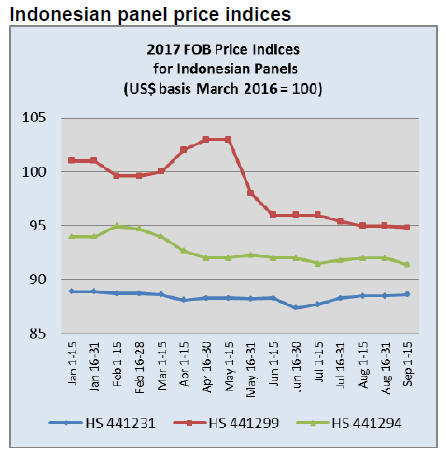
6. MYANMAR
New teak plantation investment approved
According to a press release from the Myanmar
Investment Commission a permit has been issued to UKbased
Global Agricultural Joint Venture Co Ltd. for the
establishment of teak plantations.
The investment is said to amount to USS115 million. The
area allocated for plantation development is in the
vicinity of Bago Yoma, a range of low mountains and
uplands between the Irrawaddy and the Sittaung River in
central Myanmar.
Commercial logging of the natural forest was suspended in
this area for ten years starting from 2016-17. This
investment is said to be in line with the policy of
government to ensure adequate forest resources and
expanded forest cover.
Joint venture reveals tax payments
The Myanmar Forest Joint Venture Corporation, the only
operational joint venture in the forestry sector, held its
Annual General meeting recently where it announced
gross profit of 3,515 million Kyats (around US$2.6
million).
The Forest JV Corp. stated it paid around US$13 million
in corporate tax, commercial tax and other taxes to the
state over the past 23 years. The government holds a 55%
share in this joint venture.
Infrastructure developments to open inland trade
Myanmar transport authorities are ready to pilot the
shipping of containers from Thilawa Port Myanmar
International Terminals, a deep river port 25 kilometres
south of Yangon in Myanmar to Simikhone Port.
The Simikhone Ayeyarwaddy harbour is under
construction in the Myothar Industrial City close to
Mandalay.
The test shipment will be overseen jointly by the Inland
Water Transport Authority and SA Marine Co.
In related news, India and Myanmar recently concluded an
agreement to strengthen maritime security cooperation
under a ‘White Shipping Agreement’, an information
protocol that provides for the exchange information on
shipping in oceanic territories.
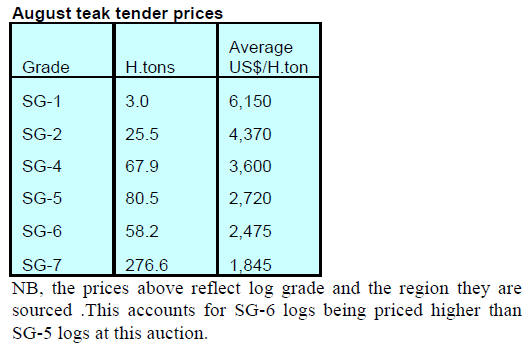
7. INDIA
Housing starts crash in first half of year
Property consultant firm Knight Frank has reported that
housing starts in India’s eight largest cities fell over 40%
in the first half of 2017, the biggest drop in the last seven
years. The weak market sentiment was, said the
consultants, due to the lingering effects of demonetization
and the problems builders are having dealing with new
regulations.
The worst affected cities were the National Capital Region
(NCR) and Ahmadabad which saw a drop of over 70% in
starts compared to a year earlier. On the bright side, the
Knight Frank report says affordable housing contributed
around 71% of the total launches in the first half of this
year up from a share of 52% in the first half of last year.
In related news Knight Frank has reported that India is
amongst the top 10 price appreciating housing markets.
For more details see:
http://www.knightfrank.co.in/news/india-among-top-10-priceappreciating-
housing-markets-knight-frank-global-house-priceindex-
q2-2017-011952.aspx
and
http://www.livemint.com/Companies/LqbH0BigmF7B4ekXhyY
TDP/Home-launches-in-JanuaryJune-fall-41-in-biggest-declinein.
html
Huge volume of illegal red sander logs seized
Red sander logs valued at Rs160 million were seized by
officials of the Directorate of Revenue Intelligence (DRI).
The logs were en-route from Chennai Port to Port Klang,
Malaysia.
A press release from the DRI said the goods had been
declared as garments and floor mats.
The export of red sanders in any form is prohibited.
Over
the past 3 years the DRI in Chennai seized 176 metric
tonnes of red sanders logs worth over Rs710 million.
Imported plantation teak
Demand for imported plantation teak remains steady. But
the burden on wholesalers of paying almost 24% in basic
duty plus GST and surcharges on logs is stretching their
cash flows to the limit. Pressure continues for a revision of
the GST on wood and wood products.
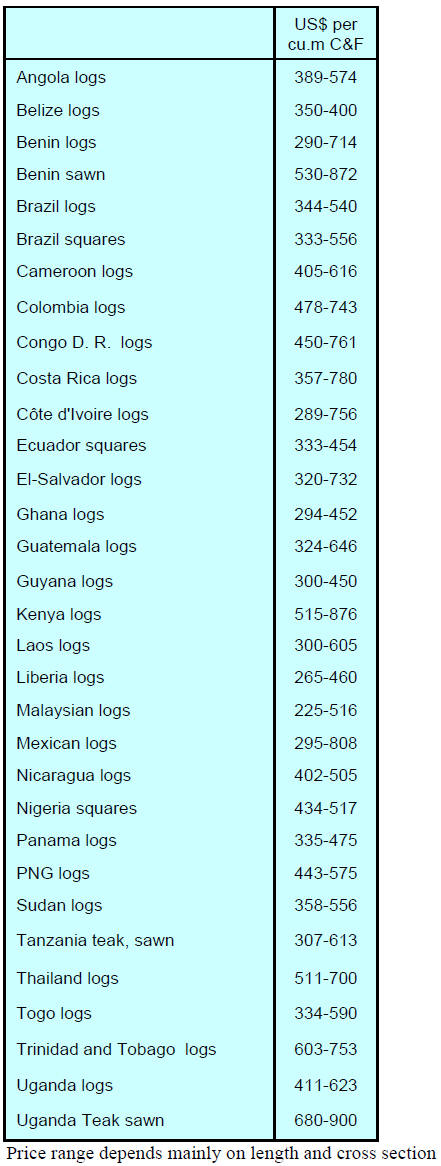
Locally sawn hardwood prices
Exmill prices for hardwoods are unchanged but are subject
to an 18% GST.
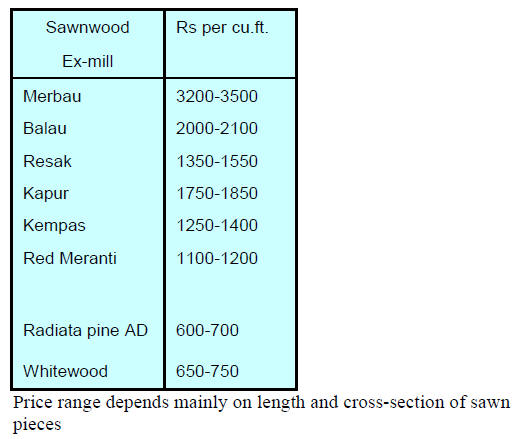
Myanmar teak prices
There were no changes in prices over the past two weeks
and the availability of sawn Myanmar teak is reported as
satisfactory. However, sales have been affected by the
high GST rates.
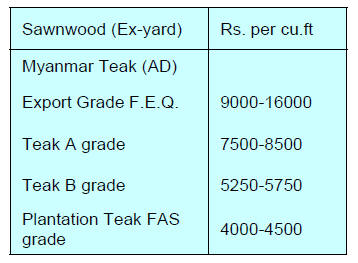
Prices for imported sawnwood
Prices for imported sawnwood (KD 12%) remain
unchanged.
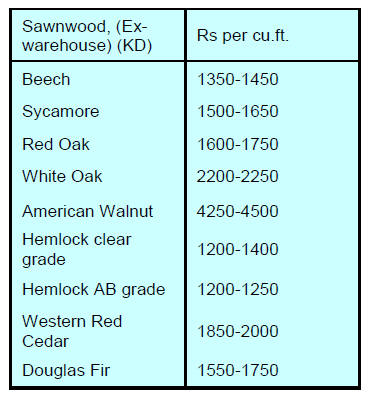
Plywood prices
Until the outcome of negotiations on the GST rates for
panels prices remain unchanged.
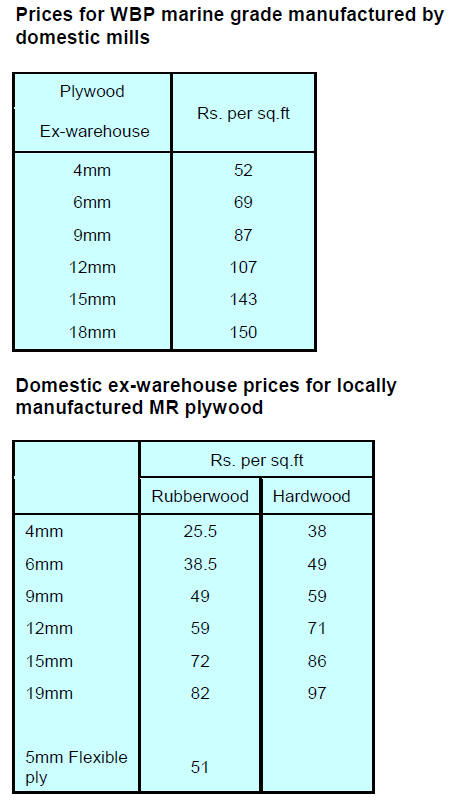
8. BRAZIL
Furniture export set to grow
After the market instability of 2016 the performance of the
Brazilian furniture industry has started to improve.
Between January to March this year furniture exports
totalled U$141 million, an 8% increase compared to the
same period in 2016.
According to IEMI (IEMI - Inteligência de Mercado)
analysis of data from the Ministry of Development,
Industry and Foreign Trade (MDIC), around 26% of
exports went to the US followed by 12% to the UK and
10% to Argentina.
Expectations for further expansion of exports in the
second half of 2017 are high even though the pace of
export growth appears to be slowing.
The industry cites rising costs as a major hurdle to be
overcome. IEMI expects a rise of 4.5% in furniture exports
in dollars for 2017.
The range of styles and quality of Brazilian furniture
industry has widened in recent years which is giving a
boost to exports according to the Brazilian Foreign Trade
Association (Associação de Comércio Exterior do Brasil -
AEB).
Economic importance of the planted forest industry
According to the Brazilian Tree Industry (IBA) 2017
report launched recently, in 2016 the Brazilian planted
forest sector experienced a crisis stemming from the
severe weakening of the national economy and forestry
sector growth fell 3.3% compared to a year earlier.
Although this 3.3% decline was significant it was lower
than seen in the overall economy (-3.6%), in the industry
in general (-3.8%) and in agriculture (-6.6%). In 2016 the
Brazilian planted forest sector contributed 1.1% to total
GDP and 6.2% of the industry sector contribution to GDP.
The Brazilian planted forest sector was responsible for
generating R$11.4 billion in federal, state, and municipal
taxes throughout 2016, which corresponds to 0.9% of all
taxes collected in the country. However, this was 5%
down year on year due mostly to the drop in domestic
sales of paper, wooden panels and solid wood products.
In 2016, export revenue from the Brazilian planted forest
industry reached US$8.9 billion, a 1.1% decrease
compared to 2015. A drop in export prices for these
products was the main reason for the fall in revenue. In
terms of volume there was a 14% increase compared to the
previous year.
Research group promotes forestry for local
communities
The Mamirauá Institute (MI), which maintains a research
group on forest ecology, is monitoring forest recovery in
the Amazonas State, northern Brazil. This is being done to
assess the sustainability of current timber management
regimes as forestry is an alternative income source for
several Amazonian communities.
The work of the institute has been recognised and certified
by the Bank of Brazil (BB) Foundation (Fundação Banco
do Brasil) and through certification the MI initiatives has
become part of the Social Technology of BB Foundation
serving as an example to be replicated in other areas.
The Mamirauá Institute's Community Forest Management
Programme is funded by the Amazon Fund, managed by
the National Development Bank (BNDES).
The Bank of Brazil Foundation´s award counts on support
from UNESCO in Brazil, the Latin American
Development Bank (CAF), the World Bank, the Food and
Agriculture Organization of the United Nations (FAO) and
the United Nations Development Program (PNUD).
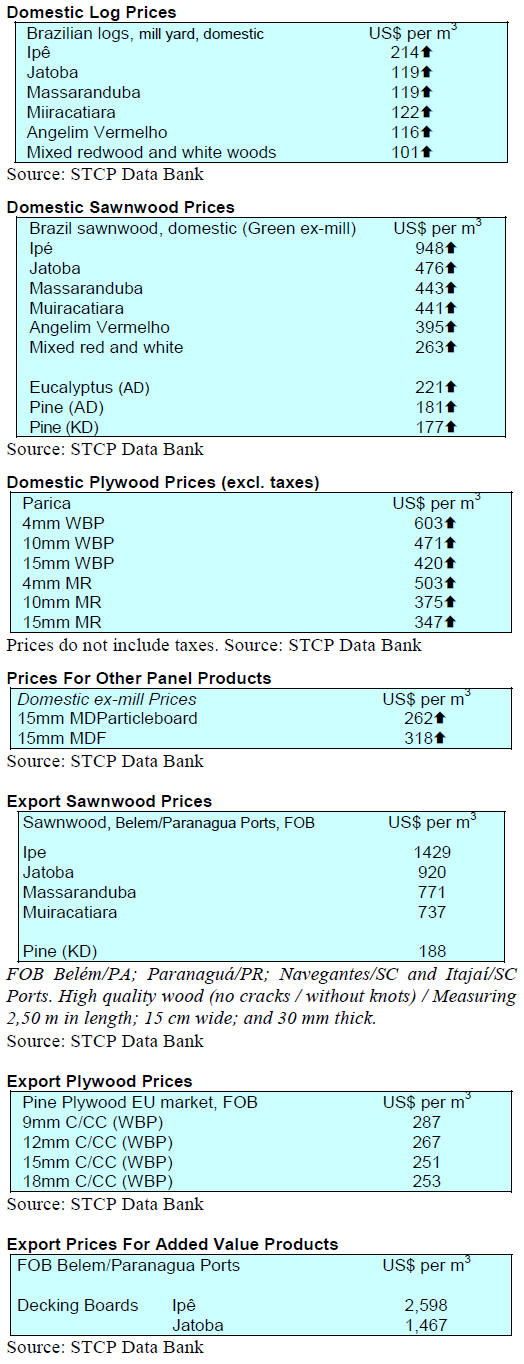
9.
PERU
Two companies lead furniture imports
The combined furniture imports of two retailers, Peruvian
Homecenters (Promart) and Sodimac accounted for 51%
of the total US$30 million furniture imports into Peru in
the first half of this year.
Imports by Promart, the brand used by Peruvian
Homecenters stores, grew 24% compared to the first half
of 2016, while first half imports by Sodimac grew 68.4%
compared to 2016. Other main importers of furniture were
Saga Falabella and Tottus Hypermarkets.
Brazil was the main supplier of furniture to Peru in the
first half of 2017 at US$ 20.2 million followed by China
(US$3.3 million), the United States (US$1 million) and
Malaysia (US1 million).
Promotion of conservation of Amazon forests
Under the National Forest Conservation Programme for
the Mitigation of Climate Change (Forest Program) the
regional government of Loreto and the Ministry of the
Environment (Minam) are joining forces to promote the
conservation of some 350,000 hectares of forests.
The Minam Forest Program provides economic incentives
to native communities for the development of productive
activities, strengthening surveillance of the forest and
improving communal management. The aim is to have
within two years approximately 350,000 hectares under a
forest conservation plan.
However, despite the best efforts of the authorities,
according to the National Forestry and Wildlife Service
(Serfor) in 2016 at total of 164,662 hectares of Amazon
rainforest were lost, an increase of 5.2% over 2015. The
Departments with the greatest loss of forest cover
compared to 2015 were Junín, Loreto, Cusco, Cajamarca,
Puno, Ayacucho, Huancavelica, Piura, Amazonas and
Pasco.
The monitoring carried out in 15 Amazonian departments
shows that in Loreto (northern area), Ucayali (Curimana),
Madre de Dios (Río Tambopata) and Junín (Anapati
River) forest losses have been recorded due to natural
events that occurred during the last three years, apparently
from wind and floods but the authorities say this requires
more detailed analysis.
During the period 2001 to 2016 there was a loss of
1,974,209 hectares of Amazon rainforest, with an annual
average loss of 123,388 hectares.
Serfor Executive Director, John Leigh, said that with these
data call for immediate preventive action against
reforestation. He emphasised that Minam is also aware of
the early warnings of an increase in loss of forest cover.
Forest Investment Plan to cut rate of
deforestation
In October 2013 Peru's Forestry Investment Plan was
approved. This was created to contribute to the reduction
of deforestation. The plan is supervised by the Ministry of
the Environment (Minam).
Three projects formulated with the support of the Inter-
American Development Bank (IDB), have been authorised
for execution beginning in 2018. A fourth project is
currently being formulated with the assistance of the
World Bank (WB) for review in late 2018.
Peru is one of the first eight countries to benefit from the
Forest Investment Program (FIP), an initiative of the
Climate Investment Funds (CIF) established by agreement
by member countries of the United Nations Framework
Convention on Climate Change in 2008.
The main objective of the FIP is to promote and facilitate
measures to promote transformational changes in public
policies for the reduction of greenhouse gas (GHG)
emissions in developing countries.
